On August 29, the three-day event DIC EXPO 2023 (Display Innovation China Expo 2023) kicked off at Shanghai New International Expo Centre (SNIEC), where display manufacturers throughout the upstream, midstream, and downstream sectors of the display industry gathered to showcase the latest technologies of novel displays.
During the event, display manufacturers (e.g., TCL, BOE, HKC, Tianma, JDI, MANTIX and Visionox), chipmakers (e.g., Prima, HGC, Highbroad, ShineOn, Chipone, ShanJin and SDK) and equipment providers (Coherent, HYC, JINGCE, ALPHABETTER, Changqi and Keyence) demonstrated their latest Mini/Micro LED, LCD, and OLED products and applications.
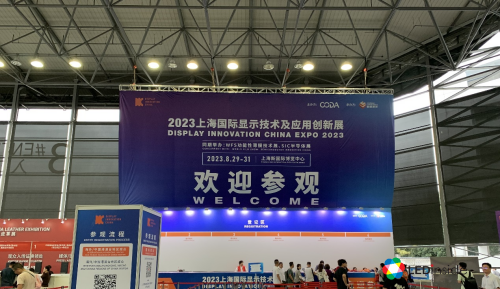
1. Display Panels
-
TCL
TCL showcased the latest applications engineered with multiple LCD and OLED technologies in TVs, monitors, commercial displays, tablets, laptops, smartphones and wearable devices.
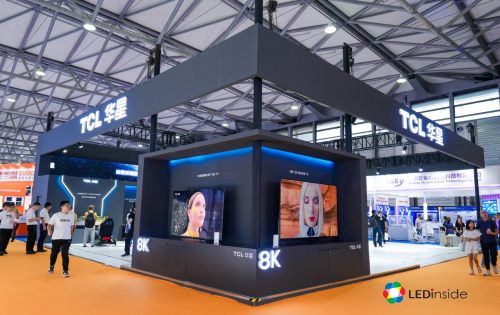
Of note, in the Mini LED category, TCL presented the world’s first 57.1-inch DUHD 240Hz R1000 curved gaming screen for the high-end market. Additionally, the company exhibited a 55-inch 240Hz R1000 ultra-curved gaming monitor, a 98-inch 8K TV and other Mini LED displays.

▲ 57.1" DUHD 240Hz R1000 curved gaming screen
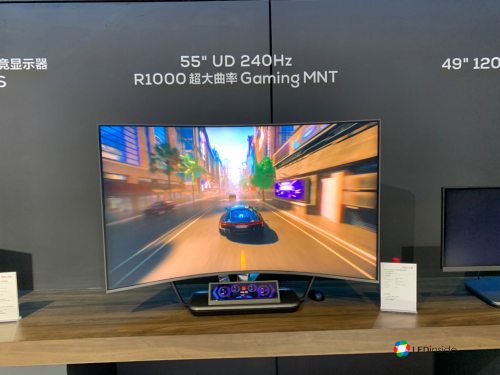
▲ 55" 240Hz R1000 ultra-curved gaming monitor
TCL also demonstrated a 65-inch 8K inkjet OLED display, which is the world’s first inkjet printing-powered OLED product boasting the largest size, highest resolution, and highest refresh rate. The display comes with up to 33 million pixels.
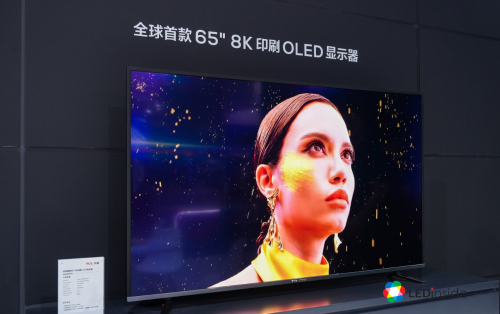
▲ 65" 8K inkjet printing OLED display
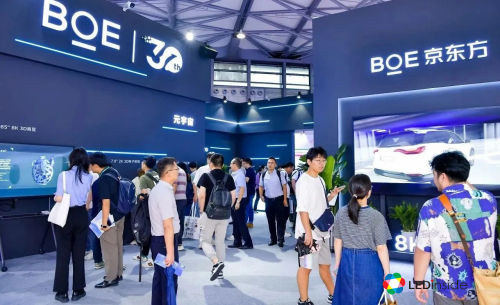
BOE unveiled ten cutting-edge display products at the event, including a 110-inch 16K UHD display, a vertically and horizontally foldable product, a 95-inch 8K OLED display, and an smart vehicle cabin. The display maker also showcased a variety of MLED applications.
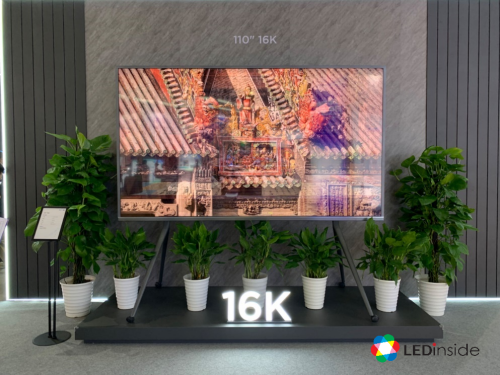
▲ 110" 16K UHD display
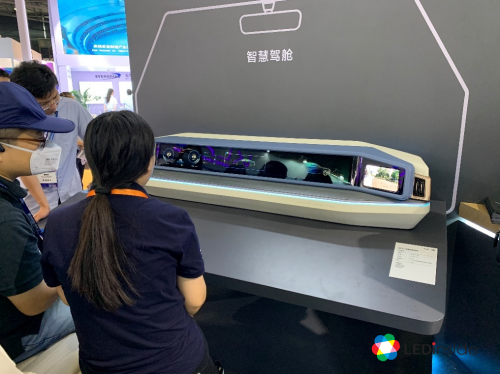
▲ 42.2" pillar-to-pillar automotive display
In terms of MLED products, BOE demonstrated the application of MLED technology in automotive displays, metaverse, and monitors.
The exhibitor presented a 14.96-inch COB MLED vehicle-mount display with a thickness of 0OD, over 1152 dimming zones, and large-angle LED chips, featuring halo reduction, a minimum brightness of 1,000 nits, ultra-high contrast and wide color gamut.
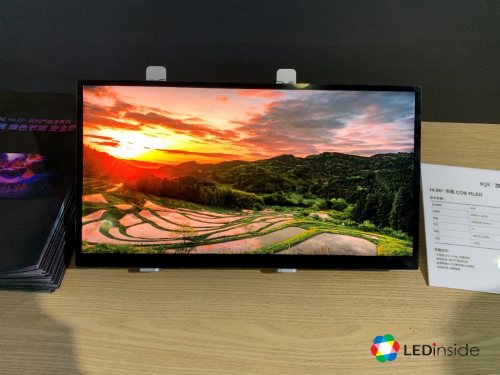
▲ 14.96" COB MLED vehicle-mount display
The 16-inch COB MLED screen, with 0OD design, has already been in mass production and applied to Asus notebook products. It features blue LEDs certified for automotive use, 1,024 backlight dimming zones, 100% DCI P3 color gamut coverage, and HDR reaching up to 1,000 nits.
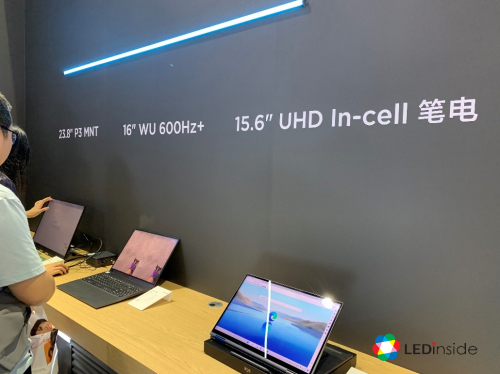
The 34-inch Mini LED-backlit display, used for AOC’s ultra-wide monitors, comes with next-gen glass-based backlight technology involving the use of 4,608 LEDs.
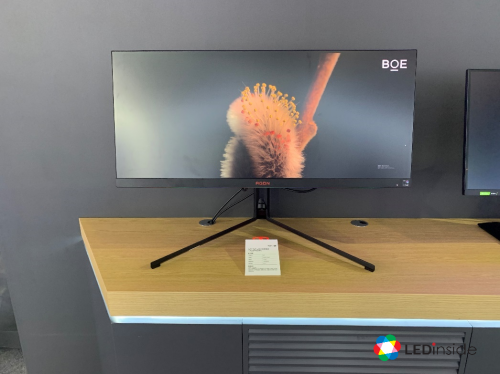
▲ AOC’s ultra-wide monitor
The 110-inch 8K 3D commercial display, powered by Mini LED backlights, boasts a contrast ratio of 1200:1 and 3D display effects.
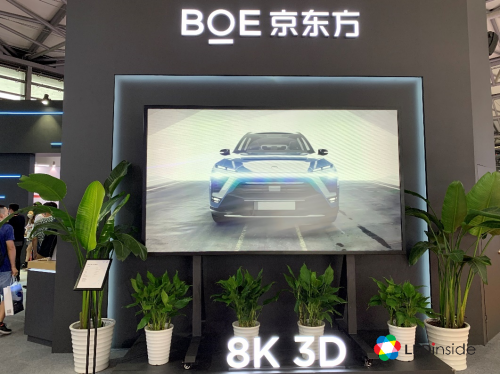
▲ 8K 3D commercial display
The 31.5-inch 4K display, coming with AM driving, boasts 4,608 dimming zones, a million-to-one contrast ratio, and a high refresh rate of 240Hz.
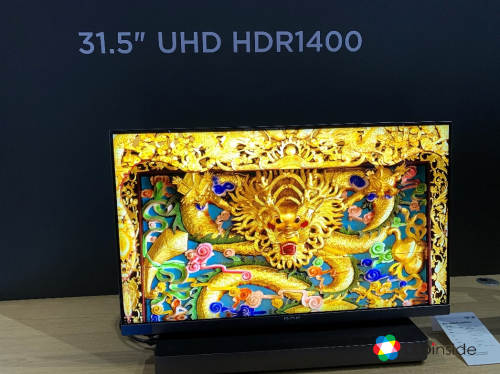
▲ 31.5" 4K display
The Mini LED-backlit smart all-in-one machine U1, equipped with BOE's proprietary ADSDS hard screen, features 6% HAZE anti-glare, professional drawing software, and ten AI-empowered capabilities.
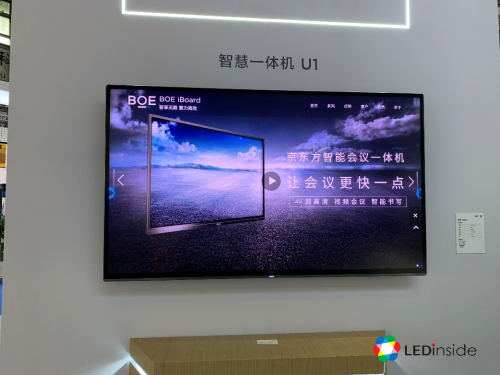
▲ Smart all-in-one machine U1
-
Tianma
Tianma unveiled the latest applications powered by Micro LED, Mini LED, and OLED technologies for consumer goods as well as the automotive, medical, industrial control sectors.
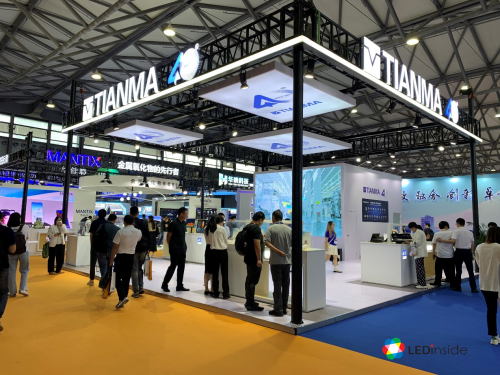
Tianma presented a variety of automotive Mini/Micro LED displays, including an 8.75-inch Micro LED transparent screen with low reflectivity (<4%), a 9.38-inch Micro LED screen featuring transparency adjustment, a 12.3-inch PM Mini LED-backlit display, a 12.3-inch PM COG Mini LED-backlit display and a 12.3-inch AM COG Mini LED-backlit display achieving HDR through proprietary algorithms.
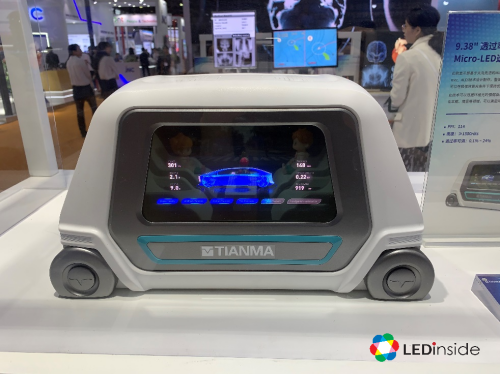
▲ 9.38" Micro LED adjustable transparent display
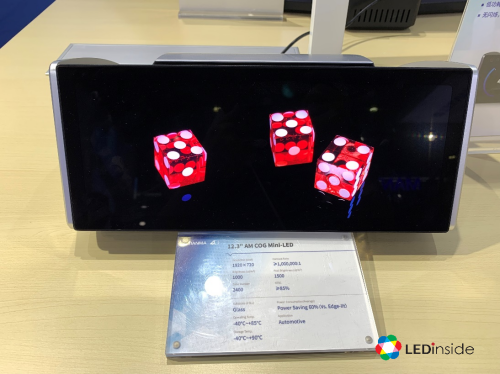
▲ 12.3" AM COG Mini LED display
As for OLED, Tianma focused on showcasing products such as a 7.92-inch AMOLED flexible display with sliding and rolling capabilities, outward-folding and triple-folding automotive displays and smartwatch displays.
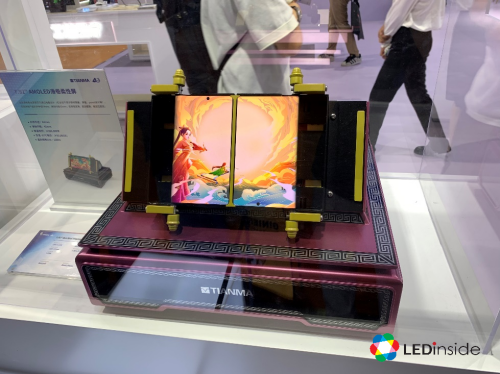
▲ 7.92" AMOLED sliding and rolling flexible display

▲ Outward-folding and triple-folding automotive displays

▲ AMOLED smart watch displays
-
HKC
At DIC 2023, HKC demonstrated display product solutions for TV, gaming, automotive, industrial control, smartphone and notebook applications, as well as Mini LED applications in various fields.
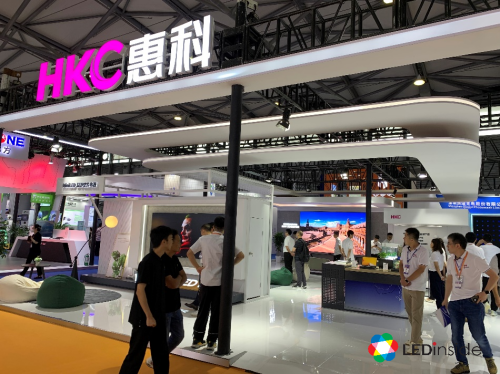
In terms of large-size displays, HKC exhibited a 107-inch Mini LED wall mount TV with QD Mini LED backlight architecture, 5,184 dimming zones, brightness of 2,000 nits, and an ultra-high dynamic contrast ratio of 100,000:1.

▲ 107" Mini LED wall mount TV
HKC’s 162" 4K Mini LED TV comes with COB packages, a P0.9 pixel pitch, brightness of 1,000 nits and a million-to-one contrast ratio.
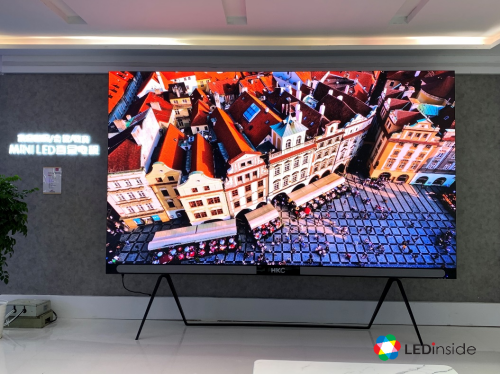
▲ 162" 4K Mini LED TV
The exhibitor also demonstrated the application of Mini LED backlight technology in gaming monitors, with multiple dimming zones, high brightness and high refresh rates as key highlights.

▲ Mini LED gaming monitors with ultra-high refresh rates
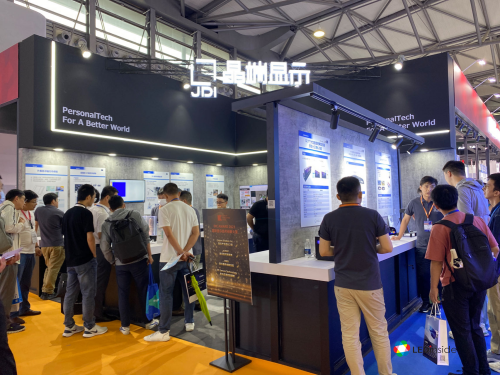
JDI showcased unique cutting-edge technologies, including its latest OLED technology eLEAP (metal-free mask Deposition) and HMO (high-mobility oxide semiconductor), as well as applications and products engineered with these new technologies.
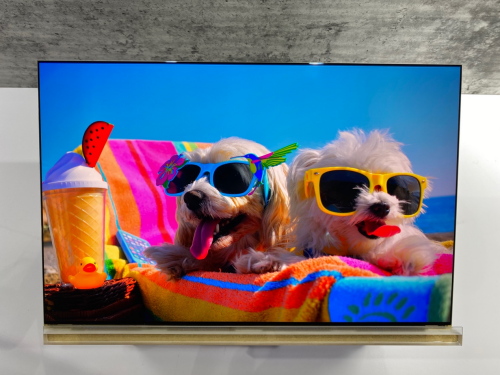
▲ A 14" prototype engineered with JDI’s eLEAP technology
According to JDI, eLEAP combines metal-free mask deposition and photolithography to form pixels, breaking through the limitations of the current largest G6 line for OLED production. It enables mass production on production lines of higher generations such as G7 and G8, improving production efficiency and yield. eLEAP brings a significant improvement in brightness and lifespan by achieving a larger proportion of the emitting area for OLED, and it also allows for product designs of any size and shape. The field-effect mobility of HMO technology is more than four times that of conventional oxide TFTs, inheriting the high resolution and high refresh rate of LTPS, while combining with the low power consumption property of conventional oxide semiconductors. JDI has already verified stable mass production for HMO.

▲ JDI’s 32.1" automotive prototype
Notably, on the afternoon of August 29, JDI held a product briefing. Mr. Yoshiharu Nakashima, chief technology officer at JDI, demonstrated and explained the company’s eLEAP and HMO technologies, introduced automotive products utilizing the new technologies, showcased a transparent interface (Realclear) with a transparency rate of up to 90%, and presented examples of new sensors, metaverse (VR) products and relevant solutions based on the display technology. Through these new technologies and products, JDI further explained its "METAGROWTH" growth strategy.
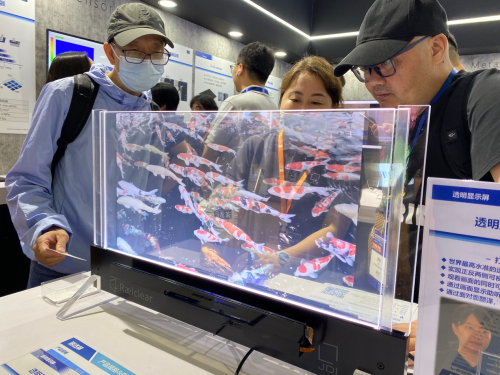
▲ 20.8" Realclear display boasting the world’s highest 90% transparency rate
In a subsequent interview, Nakashima and Guanjun Zou—general manager at JDI China—mentioned that the suspension of LCD panel production at the Tottori factory in Japan mainly involved outdated production lines. In the future, the company will focus on six major sectors: eLEAP, HMO, automotive displays, transparent displays, sensors, and AR/VR, to comprehensively develop mid- and high-end display markets.
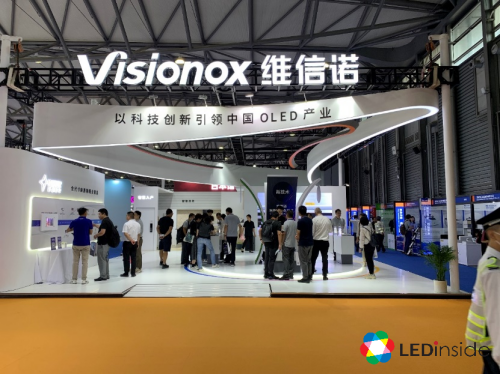
At the exhibition, Visionox's subsidiary, VISTAR, showcased its latest 14.5-inch TFT-based bezel-less Micro LED splicing screen this year. Equipped with the first dedicated driver IC in China and 25μm chips, the display comes with a pixel pitch of 500μm, contrast ratio of 500,000:1 and transfer yield rate of 99.995%.
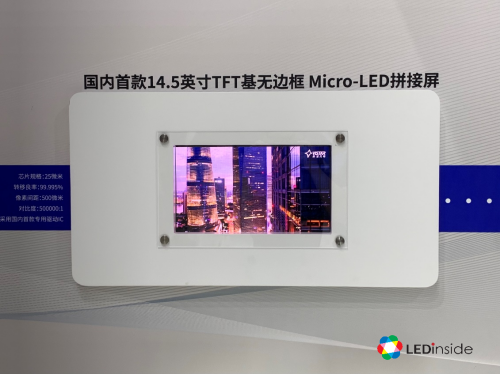
▲ 14.5" TFT-based bezel-less Micro LED splicing display
In terms of OLED, Visionox debuted an AMOLED smartphone screen with the highest refresh rate of 260Hz and the thinnest overall bezel, which will be available globally. Additionally, the manufacturer exhibited its AMOLED intelligent pixel technology, smartwatch displays, flexible screens and AMOLED displays for smart home applications.
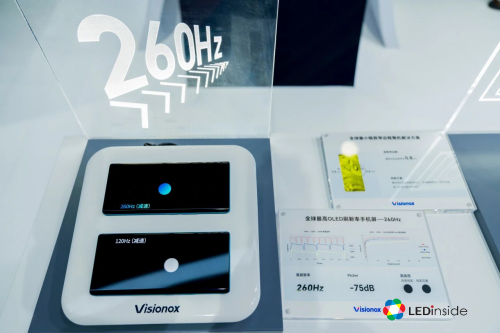
▲ Visionox’s first-ever thin-bezel smartphone screen with a high refresh rate
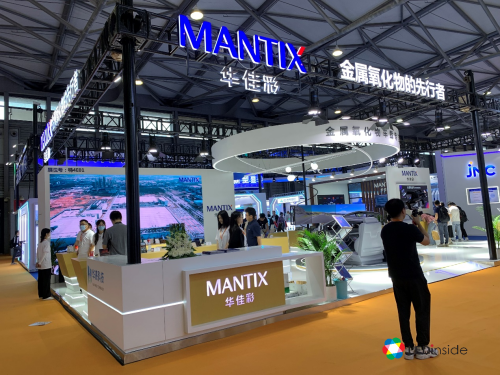
MANTIX unveiled its latest research and development achievements in metal oxide Mini LED automotive displays, OLED displays and high-end tablet screens.
MANTIX is allegedly the first Chinese manufacturer to combine metal oxide technology with Mini LED backlighting. Specifically, it introduced a 12.3-inch metal oxide embedded Mini LED touchscreen for automotive use, boasting high reliability, a high resolution, low power consumption and a low cost, with a maximum contrast ratio of 1,000,000:1.
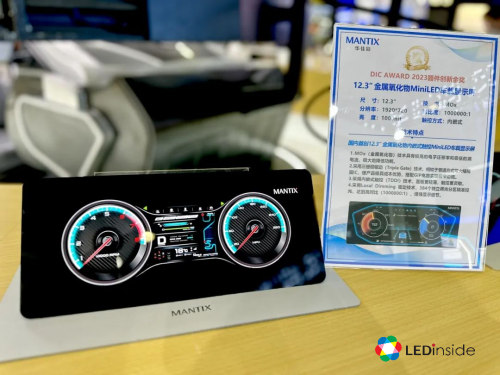
▲ 12.3" Mini LED automotive touchscreen
In addition, MANTIX showcased various displays, including a 10.25-inch metal oxide automotive display, a 13.3-inch metal oxide MUX embedded energy-saving touchscreen, a 12.6-inch metal oxide 2.5K display with a high refresh rate and high sensitivity and a 5.5-inch OLED vehicle mount display.
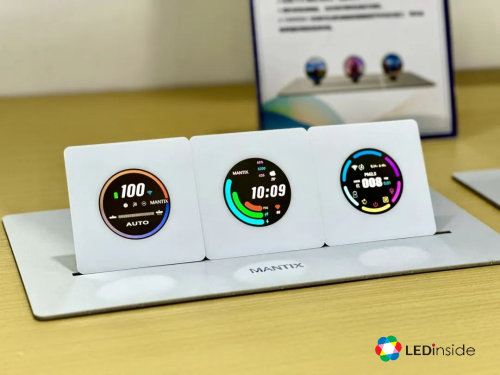
▲ 5.5" OLED vehicle mount display
2. Display Chips, Modules and Materials
-
Fujian Prima Optoelectronics
Prima specializes in the manufacturing, packaging, and R&D of high-brightness LED epi-wafers and chips. At DIC 2023, Prima released Mini LED, Micro LED, automotive LED and backlight LED products.
Prima displayed Mini LED backlights that can assist in achieving more solid-state and packaging forms for local dimming backlight modules. The chips feature zero-delay turn-on and micro-current dimming, enabling LCD displays to achieve extremely high contrast ratios.
Prima also showcased Mini LED direct-lit backlight modules, each coming with 1,536 Mini LEDs and 384 local dimming zones. The chips are packaged using COB solid-state die bonding without lead frames, making them suitable for various applications such as automotive, tablet, TV and laptop displays.
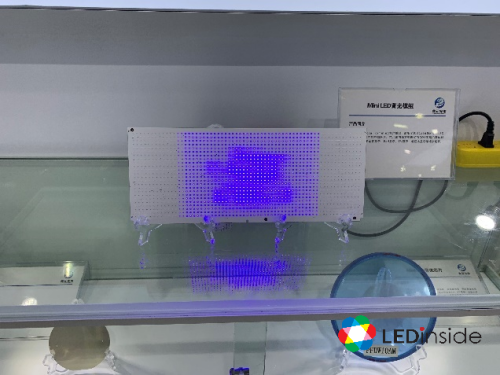
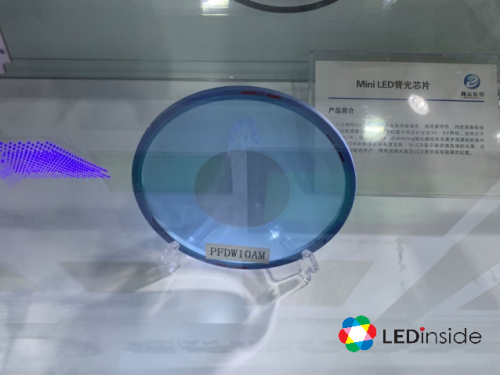
▲Mini LED backlights and backlight modules
For Micro LED, Prima exhibited integrated Micro LED chips. This series is mainly composed of green and blue diodes, which can be customized according to customer requirements. The LED maker’s existing products include 9.6μm, 9.3μm, and 8.0μm chips with pixel densities ranging from 2600ppi to 3200ppi. Each chip comprises 500,000 to 2.11 million pixels, with resolutions ranging from 812*612 to 1932*1092.
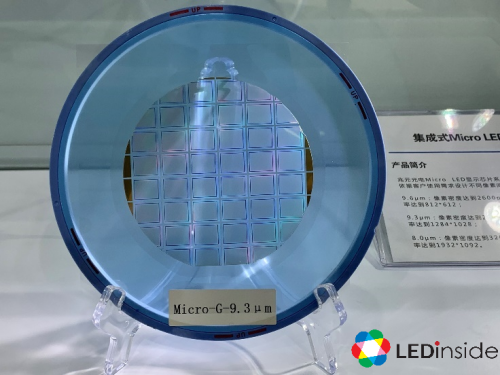
▲ 9.6μm Micro LED chips
Prima also unveiled full-color micro-display product, the Micro LED QA928, comes with a size of 8mm*6mm and a diagonal length of 0.28 inches, equivalent to 1/4 the size of a one-yuan coin. It has a resolution of 480*320, a pixel density of approximately 1200ppi, an SRGB color gamut coverage of 90%, a peak brightness of 10,000 nits and a contrast ratio exceeding 1,000,000:1.
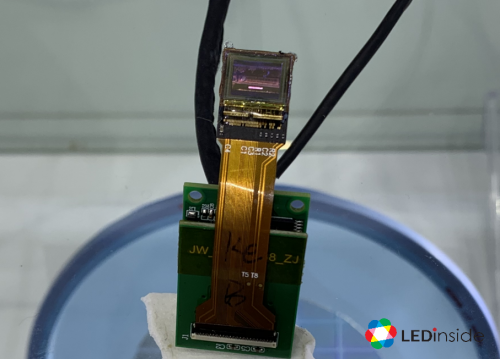
▲ Full-color Micro LED QA928
Prima displayed automotive lighting LEDs with silver as the current conduction layer and reflector, offering high conductivity, high reflectivity, high reliability and environmental resistance. The maximum input power of a single chip can be up to 6W.
Additionally, the LED manufacturer presented multiple automotive lighting modules equipped with 4 to 10 large-sized automotive chips. The overall luminous efficacy can reach 100lm/W. The products are energy-saving, durable, and can be instantly turned on, which are suitable for digital matrix LED headlights.
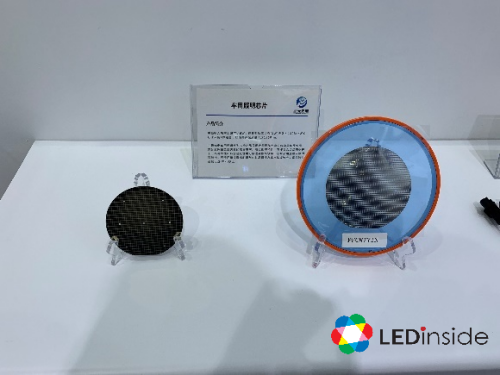
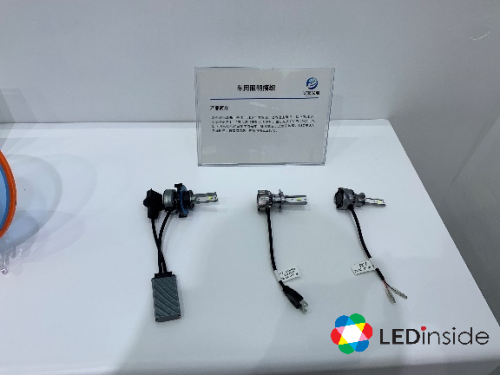
▲ Automotive lighting chips and modules
Regarding backlight LEDs, Prima showcased edge-lit wafers and chips, boasting advantages such as high brightness, long lifespan, high shear strength, low power consumption, and high luminous efficacy. They can be used as edge-lit backlight sources for smartphones and monitor panels. The edge-lit modules require fewer LED chips and are energy-efficient. Moreover, their smaller size significantly reduces the thickness of light guide plates and entire backlight modules.
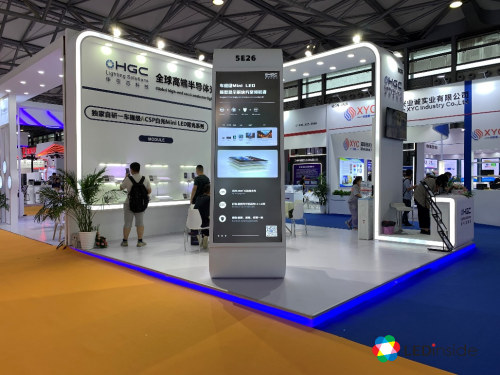
HGC, a high-end semiconductor light source IDM (integrated device manufacturer), exhibited a variety of self-developed ACSP white Mini LED backlight products. These included a 21.5-inch specialized display backlight source, a 27-inch MNT backlight board, 15.6-inch and 12.3-inch center console backlights, a 12.8-inch automotive backlight source, a 2.1-inch VR backlight source and a 5-inch HUD backlight source. These products feature high resolution, full-color control, low power consumption, high contrast, ultra-thinness and strong heat resistance, meeting the requirements of various display products such as automotive displays, near-eye displays and monitors.
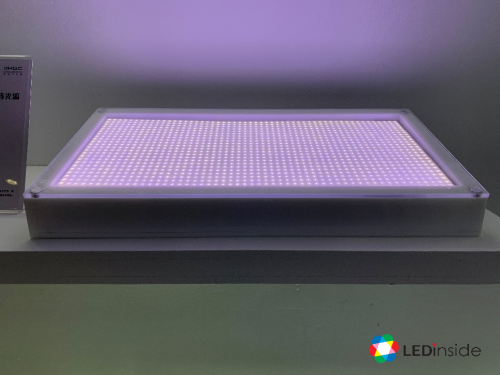
▲ 27" Mini LED MNT backlight source
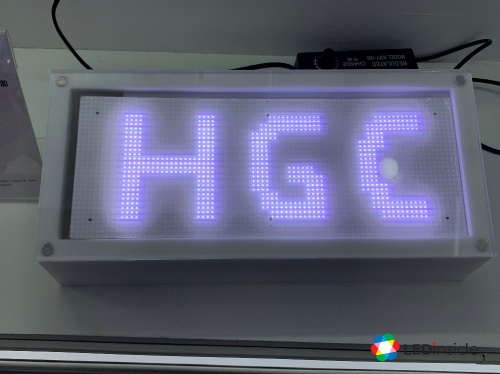
▲ 12.3" backlight source for vehicle center consoles
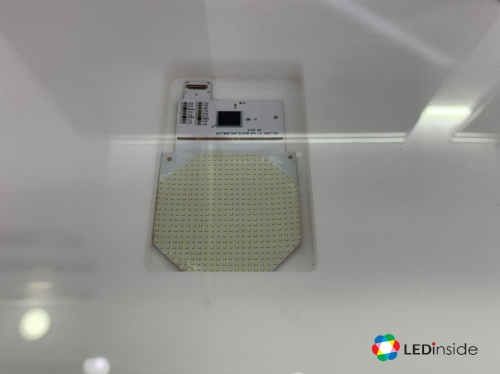
▲ 2.1" VR backlight source
Moreover, HGC showcased the self-designed and produced 15mil Mini LED chip. The product is engineered with high-activity metal oxide film and pre-fabricated Sn solder pad technologies combined with full-size omnidirectional reflective DBR and high-quality cutting techniques incorporating proprietary chip-grade beam angle adjustment, boasting high performance, reliability and light pattern control capabilities.

▲ 15mil Mini LED chip

Highbroad has already started the mass production of Mini LED backlight module-related products, which are widely applied to various fields such as laptops, desktop monitors, tablets, vehicle mount displays, and VR displays.
At this exhibition, Highbroad manifested a wide range of Mini LED-backlit displays. These included a 17-inch light board encapsulated with micro lenses, a 16-inch COB blue light board with full-face and grid encapsulation, featuring 10,368 LEDs and 1,152 local dimming zones. The manufacturer also displayed a 6.63-inch Mini LED reflector produced using vacuum forming and injection molding. Furthermore, the presented 16-inch COB blue light Mini LED display module comprises 18,432 LEDs and 2,048 dimming zones.
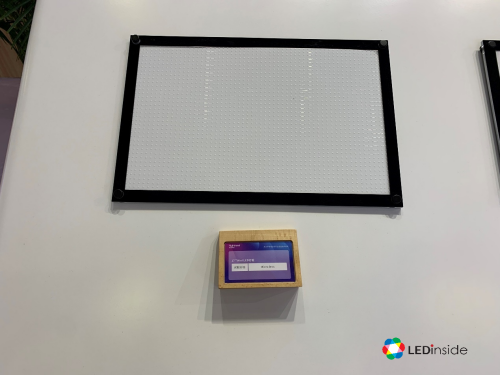
▲ 17-inch light board encapsulated with micro lenses
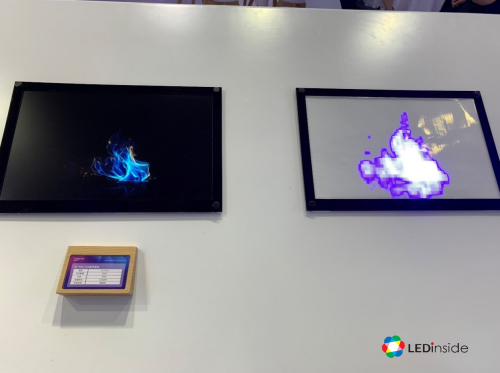
▲ 16-inch COB blue light Mini LED display module
Highbroad also revealed other backlight products and applications, including a 14-inch high-brightness light guide plate and privacy display module.
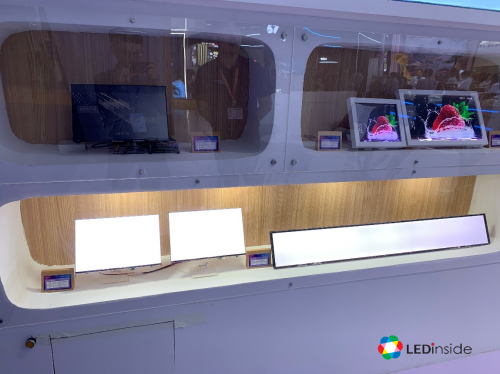
▲ Light guide plate with high brightness and privacy display module
ShineOn showcased Mini LED POB blue and white light modules, Mini LED COB white light modules, in-vehicle Mini LEDs and conventional edge-lit light sources at DIC 2023.
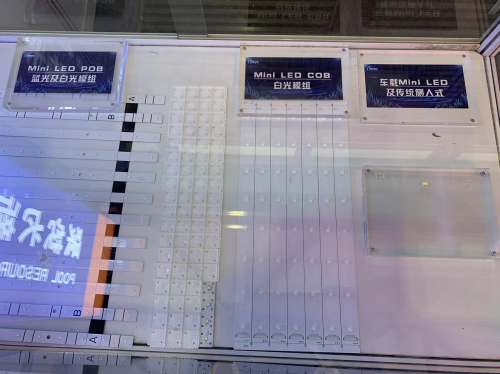
▲ Mini LED product portfolio
ShineOn’s self-developed white light COB solution comprises blue chip + fluorescent powder combined with dispensing wide-angle technology, eliminating multiple costs such as QD materials and packaging lead frames. Under the same display performance, it reduces costs by 20% compared to blue light COB solutions.
Their cost-effective white light POB products support all standard packaging sizes (such as 3030, 2016, 2835, CSP, etc.). Under the same brightness specifications, they can increase the maximum beam angle to 180°, thereby maximizing LED cost savings. These products also support various business models.
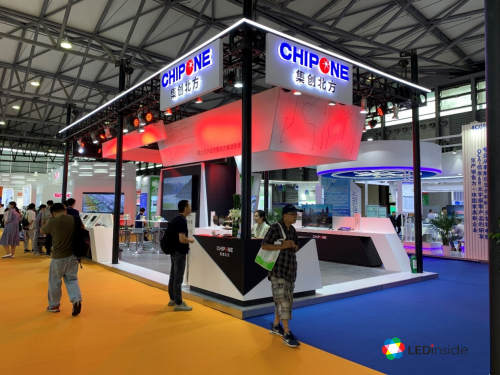
Chipone, which specializes in the research, design, and sales of display chips, showcased an extensive product lineup featuring mainstream display technologies like LCD, LED, and OLED. The company’s primary products include panel driver chips, power management chips, LED display driver chips, and control chips.
During the exhibition, Chipone displayed the LED backlight display driver IC ICND8603, a product produced using high-voltage process. It supports a 960Hz refresh rate under the minimum grayscale level, 3,840Hz refresh rate under 14-bit grayscale and maintains the integrity of the image even under high shutter speed in photography.
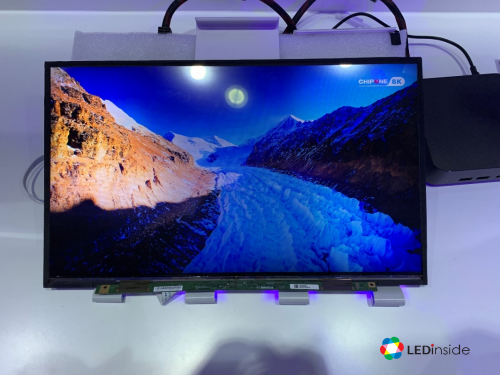
▲ Driver IC ICND8603 for LED-backlit displays
The manufacturer also presented display driver IC products, including a Si-based OLED chip for AR glasses, TDDI (Touch and Display Driver Integration) chips, an LCD display and two-in-one touchscreen chip supporting 720RGB*1760 and a whopping 90Hz refresh rate, and an OLED display driver IC compatible with dynamic frequency scaling and crosstalk compensation algorithms.
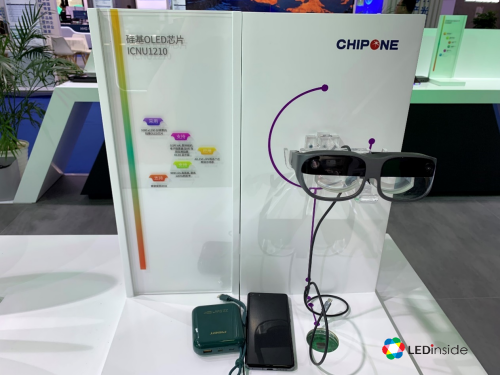
▲ Si-based OLED chip for AR glasses
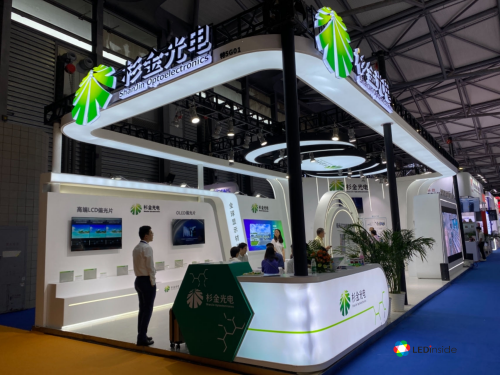
ShanJin divided its products into several display areas, namely the areas of high-end LCD polarizers, mid- and small-size polarizers, eco-friendly solvents, smart manufacturing and interaction and experience.
In particular, ShanJin has been focusing on investing in the development of new OLED polarizers, for which the exhibitor displayed a TV, IT product, mobile product, and foldable product during the event. Some of the models have been mass produced. The high-end LCD area features products with strong competitiveness, including an SLR polarizer (super low reflection), an ATW (advanced true wide polarizer), an RF polarizer, and a polarizer for outdoor round displays. The mid- and small-size polarizer area comprises components tailored for VR glasses, mobile use and tablets.
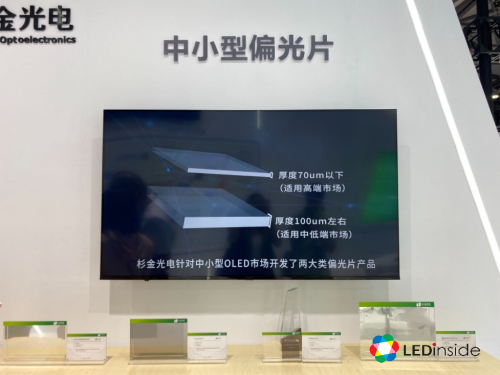
▲ High-end mid- and small-size polarizers
Le Zhang, head of development at ShanJin, told LEDinside that the company has been investing more in the development of mid- and small-sized polarizers for high-end markets in recent years, including OLED TVs, tablets, vehicle mount displays, and AR/VR applications.
On the market front, Zhang stated that the panel manufacturing sector is currently maintaining stable and healthy growth. Concerning demand, the trend toward larger-sized TV panels will drive the market demand for upstream materials. He also expressed optimism about the growth potential of Mini LED backlighting. Additionally, sports events like next year's sporting competitions are expected to become a significant driver of demand for the panel industry. In this context, ShanJin will maintain close contact and collaboration with downstream customers, bolstering market competitiveness and solidifying its market position through high-value-added products.
SDK presented its latest products and technologies in high-end optical materials, roll-to-roll lamination processes, and solutions for foldable screens, smartphones, VR glasses, and tablet applications. In the exhibition area of high-end optical materials, the company introduced functional optical film products, including optical clear adhesive (OCA), as well as AR/AF/AG coatings. Additionally, SDK showcased the proprietary roll-to-roll lamination process, which can meet customers’ stack structure designs, effectively improving product yields and production capacity.
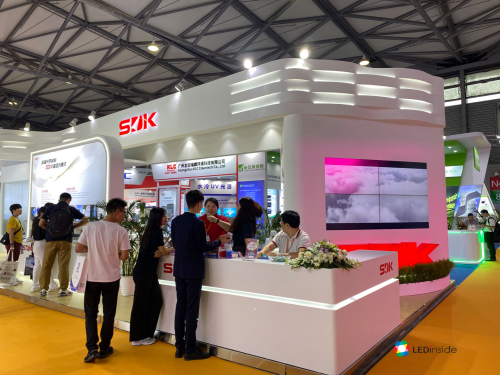
SDK has an extensive experience in the application of its high-end optical materials, and some products launched by panel customers at DIC 2023 also come with its solutions. In the future, SDK plans to develop solutions for multiple structures combining AR coatings, OCA, PET substrates, and other functional optical films in multilayer composite structures to enhance optical performance. Leveraging SDK’s years of coating experience and process control capabilities, this is expected to significantly optimize yield and cost.
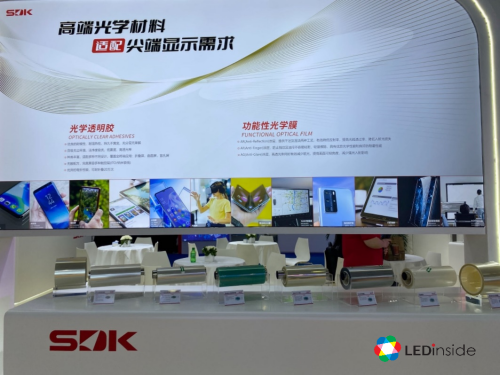
▲ OCA and functional optical film
In terms of collaboration, SDK has taken a different approach compared to the past, where it used to interact with end customers through die-cutting businesses. In recent years, based on an embedded R&D concept, SDK has accelerated cooperation with midstream panel manufacturers and end customers. They work together to explore, design, and develop solutions that meet specific needs, fully leveraging the vertical integration of the industry chain.
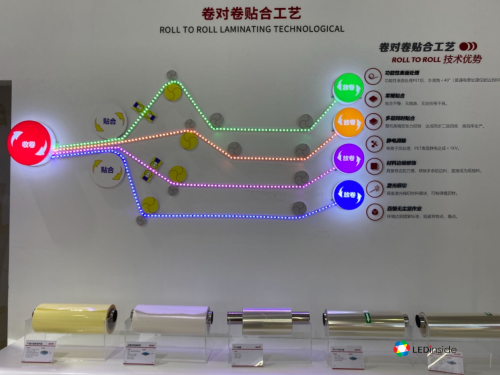
▲ Roll-to-roll lamination process
Given the increasing call for the replacement of imported products with those made in China, materials jointly developed by SDK and end customers have been successfully introduced and are in stable production. This has broken the monopoly of foreign manufacturers. In the future, SDK will continue to work closely with its customers to seize the opportunities for advancing domestic materials and surpassing its foreign competitors.
3. Display Manufacturing and Inspection Equipment

▲ Display manufacturing and inspection equipment
Coherent showcased its Vtransfer three-in-one Micro LED laser processing system, featuring laser lift-off, mass transfer and laser repair. The system employs a mask-based imaging mechanism, offering ultra-high optical resolution (5μm). It utilizes high-precision visual feedback and control, ensuring high-precision transfer. With the use of ultraviolet excimer lasers, it boasts high energy and a large spot size, enabling large-area transfer.
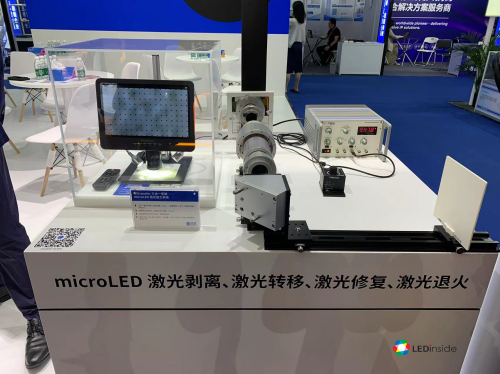
▲ Three-in-one Micro LED laser processing system
In addition to Micro LED, the equipment provider presented a variety of display panel manufacturing equipment, including equipment for flexible OLED cutting, laser annealing, thin-film/polarizer cutting and glass/sapphire cutting as well as AR solutions.
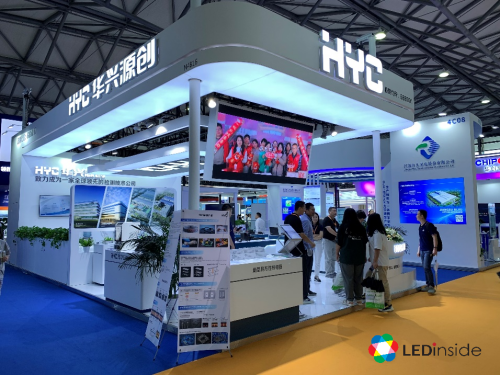
As a provider of industrial inspection equipment and integrated testing system solutions, HYC specializes in the research, development, production, and sales of inspection equipment for flat-panel displays, smart wearables, semiconductors and automotive electronics. Moreover, HYC was allegedly responsible for the testing phase of Apple’s Vision Pro head-mounted device announced in June.
In the field of flat-panel displays, HYC offers equipment for LCD/OLED module-related inspections, as well as testing equipment for next-generation micro display modules like Micro OLED/LED and Mini LED.
During the exhibition, HYC showcased several testing devices, including the Tomcat inspection equipment capable of inspecting smartwatch screens as well as current, voltage and touch functionality. The equipment provider also presented the Mini DVA, a device for detecting defects in smartphone screens that can provide its own voltage and drive signals. Furthermore, the exhibited 4-channel GMSL in-vehicle screen inspection machine with multi-angle spectrometers enables simultaneous analysis of screen optical characteristics from six angles. Additionally, HYC displayed a color analyzer portfolio suitable for testing various types of novel display screens.
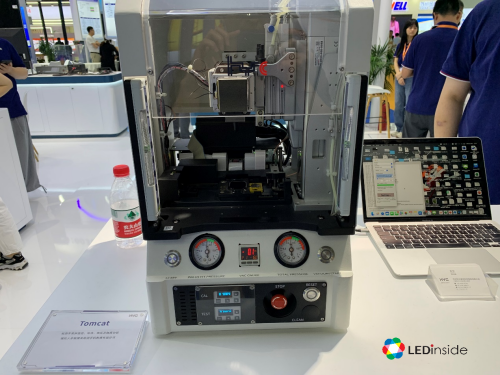
▲ Tomcat smartwatch screen inspection equipment
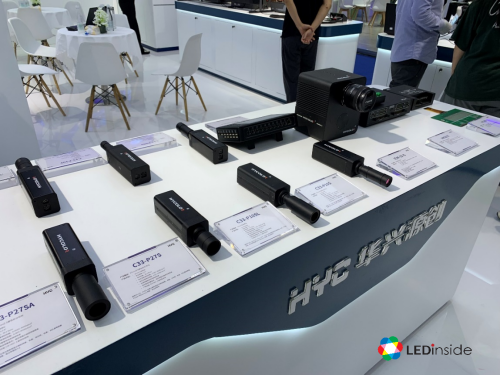
▲ Portfolio of display color analyzers
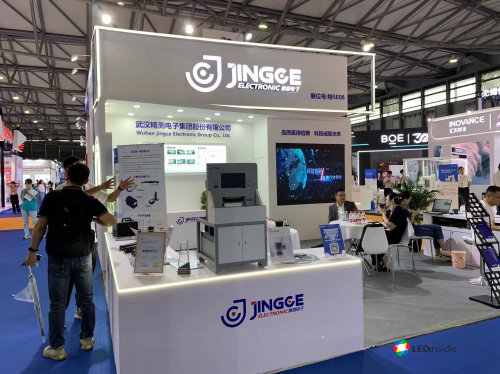
JINGCE primarily engages in the research, development, production, and sales of inspection systems for displays, semiconductors, and renewable energy applications. The company’s main products for the display sector encompass testing equipment for LCD, OLED and Mini/Micro LED displays. These products include signal detection systems, OLED debugging systems, AOI optical inspection systems, and automation equipment for flat-panel displays.
During the exhibition, JINGCE Electronics showcased the GI361 OLED module signal generator, which can be used for testing small to medium-sized OLED and Micro LED modules. It features ultra-high data rates, compatibility with all signal formats, high power output and an open platform design.
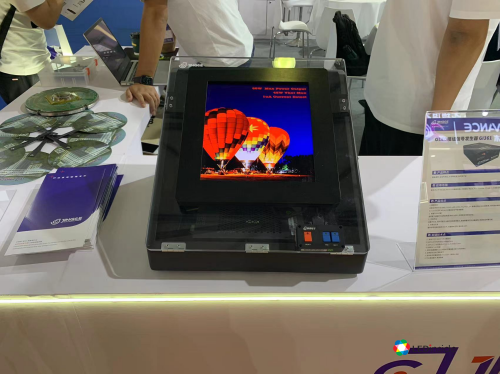
▲ GI361 OLED module signal generator
JINGCE also presented NED inspection equipment used in the development and production of VR end products. This equipment combines an NED probe, chroma meters, and spectrometer to achieve absolute luminance measurement. It can also perform bright- and dark-spot AO1 testing and optical performance analysis. Additionally, JINCE exhibited its JC-EYE-2 series color analyzers and JCS-3000 spectroradiometers, among other display testing products.
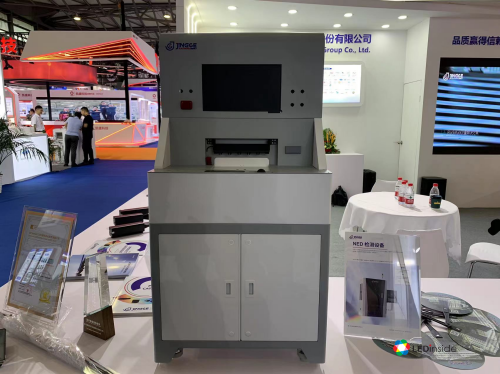
▲ NED inspection equipment
-
ALPHABETTER
ALPHABETTER showcased two Mini/Micro LED inspection devices. The Micro LED mass inspection system, engineered with photoluminescence (PL) combined with automated optical inspection (AOI), enables non-contact, non-destructive, and ultra-fast emission performance testing. It can inspect wafer surface brightness/shape information, chromaticity information and spectral information.
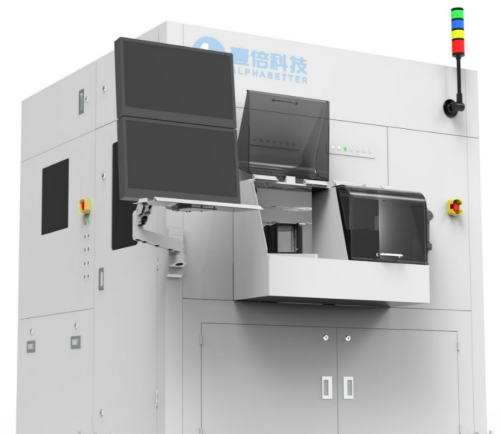
▲ Micro LED mass inspection system
The Mini LED mass inspection system comes with a technology solution that combines PL and AOI, reducing the number of required electroluminescence testing equipment for electrical performance. This significantly increases testing capacity and is estimated to reduce the testing equipment costs and other associated costs for Mini LED foundries by more than 60%.
-
Changqi
As a major supplier of dynamic aging and inspection equipment for LCDs, Changqi showcased its LCD dynamic aging rooms at the DIC exhibition, including classic models such as the three-chamber aging room and track-line automatic aging room.
Changqi's TK-L track-line automotive aging models feature automatic feeding, automatic aging testing, automatic surge-free screen light-up testing, real-time collection, detection and analysis of voltage, currents and images for display products. During the aging process along the track, the product allows the screen to refresh without interruption; it can also automatically discharge. The aging room features continuous feeding, aging testing, and discharging 24/7, achieving automatic control for the entire aging process of displays. Compared to conventional aging testing equipment with the same production capacity, Changqi's track-line automatic aging room can increase the efficiency of aging testing by more than 2 times, reduce thermal energy consumption by more than 50% and save more than 50% of labor costs. This is advantageous for LCD companies in enhancing market competitiveness and profitability, especially in the current highly competitive environment.
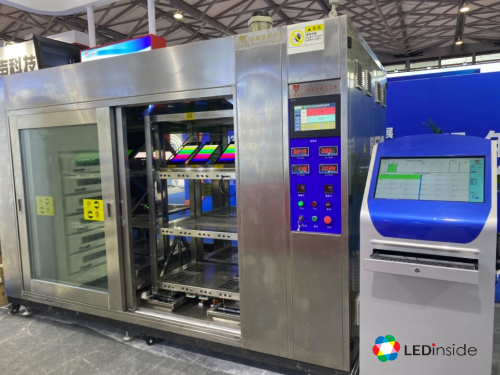
Dongxian Lu, general manager at Changqi, mentioned in an interview with LEDinside that thanks to technological innovation and the high degree of automation in, Changqi's liquid crystal aging testing equipment helps reduce energy consumption and costs by more than 50% compared to their conventional counterparts. Compared to similar products in the market, they boast energy savings of over 30%. The products demonstrate strong advantages in terms of stability, yield and cost, meeting the market's demand for energy savings and cost reduction, thereby enhancing the core competitiveness of the company’s products.
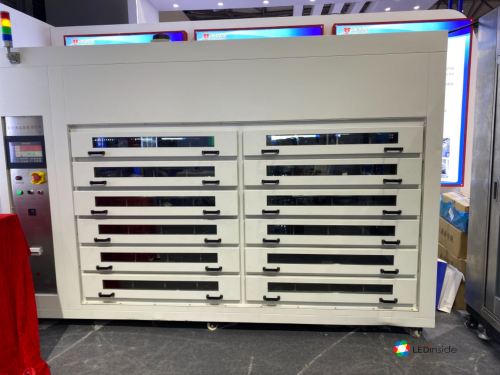
In the future, Changqi will continue to increase its research and development investments and expand its patent portfolio (currently holding more than 100 patents) to provide customers with guarantees of quality and intellectual property rights. Regarding production capacity, Lu stated that as the LCD market is currently undergoing reshuffling, the company is being extremely cautious about customers with weak competitiveness and poor payment terms. Based on current market demand, Changqi will temporarily maintain its existing production capacity this year, retain existing customers and establish relationships with trustworthy new customers. The company plans to cautiously expand production and adjust timely to mitigate potential risks.
Keyence
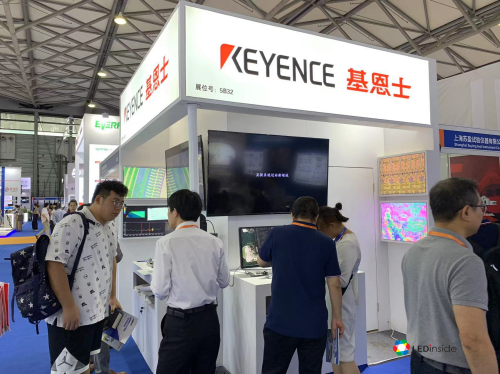
Keyence is a supplier of various industrial automation products, with the product portfolio spanning from digital microscopes, vision/barcode readers, PLC/engraving equipment to measurement devices and more.
At the exhibition, Keyence showcased its digital microscopy systems, the VHX series. With object examination, photography, and measurement capabilities, the products allow for a depth of field equivalent to or greater than a 20x optical microscope. It can perform plane, 3D, roughness, cleanliness and grain-size measurement, meeting the production and inspection needs of various industries including the display industry.
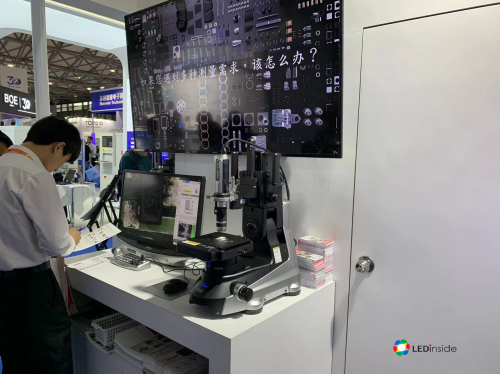
▲ VHX series
By Irving and Janice from LEDinside
TrendForce 2023 Micro LED Market Trend and Technology Cost Analysis
Release Date: 31 May / 30 November 2023
Language: Traditional Chinese / English
Format: PDF
Page: 160 / Year
TrendForce 2022 Mini LED New Backlight Display Trend Analysis
Publication Dates: April 30 and October 31, 2022
Language: Traditional Chinese/English
Format: PDF
Number of Pages: The two publications will total 120–130 pages
If you would like to know more details , please contact:


















































































